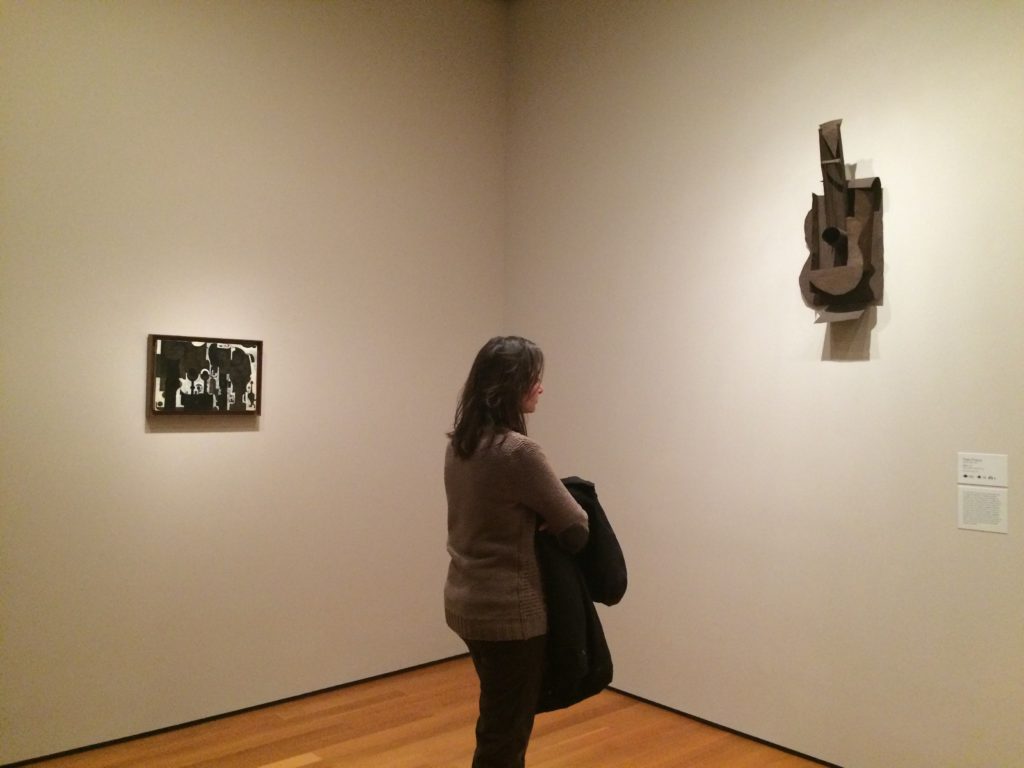Disrupting the Narrative: Political Resistance at the Museum of Modern Art
The fifth floor of the Museum of Modern Art is devoted to the Museum’s permanent collection of works from the late 19th to the mid 20th centuries. This is the place where one can find, moving from one gallery to the next, the instantly recognizable works of the art historical timeline: Vincent Van Gogh’s The Starry Night, Pablo Picasso’s Les Demoiselles d’Avignon, and Henri Matisse’s Dance. However, as of early February, this is also the place where one can find one of the institutional art world’s most public expressions of resistance to Donald Trump’s travel ban.
After Trump signed the executive order banning the entrance to the United States of refugees and citizens from seven majority-Muslim countries, MoMA curators interspersed works by artists from these targeted nations throughout the fifth floor. In total, there are seven works now hanging where before was only art by canonized Western artists like Picasso and Matisse. Their wall labels include a block of text that explains, “This work is by an artist from a nation whose citizens are being denied entry into the United States, according to a presidential executive order issued on Jan. 27, 2017. This is one of several such artworks from the Museum’s collection installed throughout the fifth-floor galleries to affirm the ideals of welcome and freedom as vital to this Museum as they are to the United States.”

When I visited the newly rehung galleries, I arrived ready to see how the curators integrated these new artworks into the narrative flow—that modernist timeline– that defines the fifth floor. How would these works complement the bastion pieces with which they share wallspace? What similarities have the curators encouraged us to find between, say, the Iranian artist Faramarz Pilaram’s Laminations (Les Lames) and Jackson Pollock’s One: Number 31, 1950 hung just across the hallway?
These, however, are the wrong questions to ask of MoMa’s rehang and fortunately, more times than not, the new works appear intentionally disruptive to the floor’s timeline and organization. Laminations dates not much later than One: Number 31, 1950 and also shares a certain flatness with the other works in its gallery. However, the pen and colored ink K+L+32+H+4. Mon père et moi (My Father and I) by Iranian artist Charles Hossein Zenderoudi fits less easily in the Matisse gallery where it now hangs. The dense ornamentation of the work seems a contrast to the pure color and simplified landscape of Matisse’s Dance, which it confronts from across a corner. In fact, the ornamentation actually better recalls Matisse’s orientalist odalisque paintings, which do not hang in the room.

In light of this, Zenderoudi’s placement in the Matisse gallery reminds the viewer of the ways in which Western artists have continually appropriated and exoticized cultures deemed “other” in pursuit of their art. The Mosque, a painting by Sudanese artist Ibrahim El-Salahi, sends such a message more overtly from its place embedded in a collection of Picasso works. There it stands as a reminder of the artist’s mining of West and Central African art, an influence he adopted without understanding of the meaning or function of the sculptures that so inspired him. It was an appropriation that reasserted Picasso’s supremacy over the African artists who created such works, an inspiration he was loathe to acknowledge.

Coming to The Mosque after viewing Les Demoiselles, with its famous yet racist and misogynistic use of African masks, extinguished any desire on my part for these new works to complement the floor’s preexisting ones. My original expectation was to seek just a continuation of the visual argument set out by the traditional narrative of exhibits like MoMA’s fifth floor. By its logic, non-Western works, at best, serve to enhance our understanding of canonized works that are truly “great,” that such works should serve to support the existing timeline of art history rather than disrupt it and our notions of “great” art. That is, I am far from singling Matisse and Picasso out. The narratives of our art institutions often say much the same thing that these artists’ works do.

Disrupting their conventional narrative, MoMA’s rehang is undoubtedly a powerful statement, especially because these new works are ones whose creators, if Trump is to have his way, would not be able to see their work beside Picasso’s. However, it still stands that the narrative of modern art told by MoMA did not have a place for this art before the ban. The curators’ gesture of inclusion highlights the fact that there is indeed something exclusionary about the Western-centric model of modernism on its walls. In what ways has this narrative failed to combat, if not contributed to, the position in which we stand today? If MoMA and other museums can tell a story of modern artistic development largely devoid of non-Western accomplishments and voices, should one be surprised when people fail to recognize the value of these voices now and in the future? In other words, that these seven artworks are on MoMa’s fifth floor is not a permanent change. But, perhaps it should be.
Gabriella Costa is a senior at Fordham College Rose Hill. She is double majoring in Art History and English with a focus on Modernism in both literature and art.